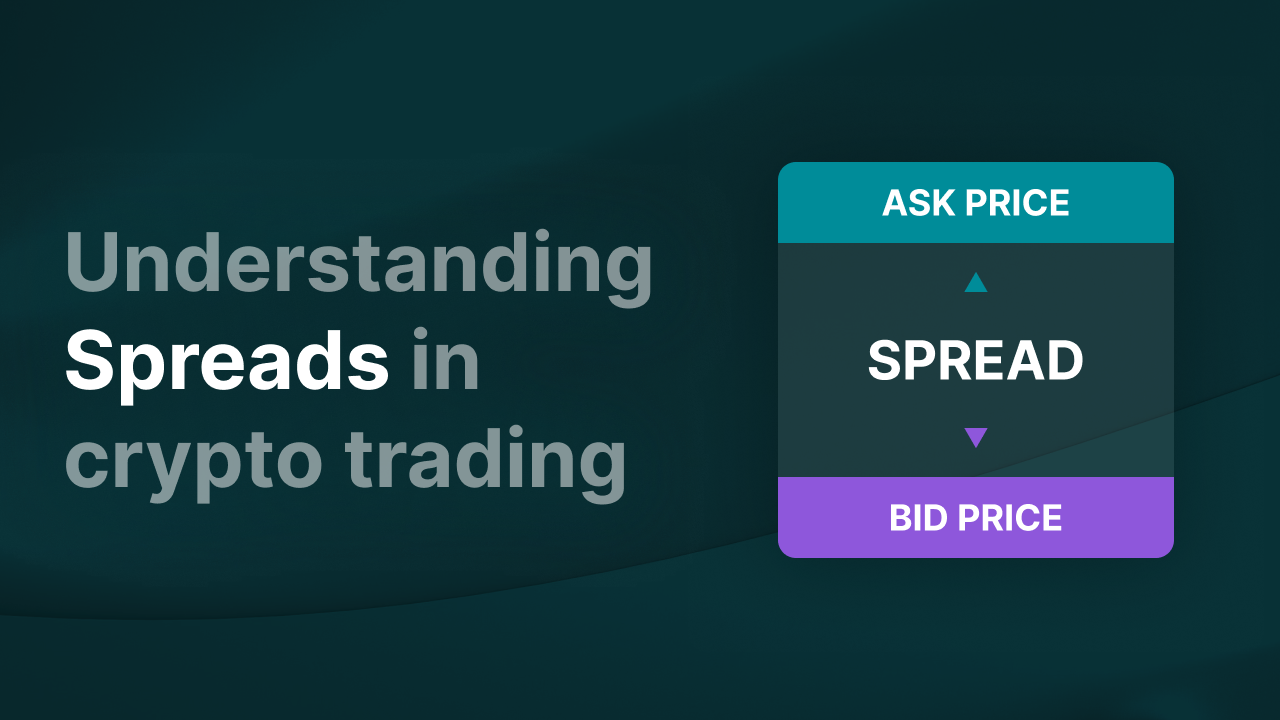Spreads im Krypto-Trading: Ein umfassender Leitfaden

Was ist ein Spread im Krypto-Trading?
Ein Spread im Krypto-Trading ist die Differenz zwischen dem Kaufpreis (Bid) und dem Verkaufspreis (Ask) einer Kryptowährung. Der Bid-Preis ist der höchste Preis, den ein Käufer bereit ist zu zahlen, während der Ask-Preis der niedrigste Preis ist, den ein Verkäufer akzeptiert. Der Spread, also die Differenz, ist ein zentraler Kostenfaktor beim Trading und beeinflusst maßgeblich die Rentabilität auf den Krypto- und Finanzmärkten.
Beispiel:
Angenommen, du möchtest Bitcoin (BTC) kaufen.
- Der Bid-Preis beträgt 29.950 €
- Der Ask-Preis beträgt 30.000 €
Die Differenz ergibt den Spread:
30.000 € - 29.950 € = 50 €
Das bedeutet, du „startest“ direkt mit einem Nachteil von 50 € pro Bitcoin. Würdest du sofort wieder verkaufen, würdest du diesen Betrag aufgrund des Spreads verlieren, Transaktionskosten nicht eingerechnet.
Wichtigste Erkenntnisse
- Ein Spread im Krypto-Trading ist die Differenz zwischen Bid- und Ask-Preis einer Kryptowährung und stellt einen bedeutenden Kostenfaktor dar.
- Zu den Spread-Typen gehören: Bid-Ask Spread, prozentualer Spread, fester Spread und variabler Spread, der von der Marktvolatilität abhängt.
- Je kleiner der Spread, desto geringer die Handelskosten, besonders wichtig für aktive Trader.
- Spreads werden durch Faktoren wie Liquidität, Volatilität, Börsenkosten, makroökonomische Ereignisse und das Verhalten von Market Makern beeinflusst.
- Ein hoher Spread kann auf geringe Liquidität oder einen volatilen Markt hindeuten und höhere Einstiegskosten sowie Slippage verursachen.
- Du kannst Spread-Kosten senken, indem du Limit Orders nutzt, während aktiver Marktzeiten handelst und beliebte Coins mit hohem Volumen auswählst.
Arten von Spreads im Krypto-Trading
-
Bid-Ask Spread: Die gängigste Form des Spreads. Sie beschreibt die Differenz zwischen dem höchsten Kaufpreis und dem niedrigsten Verkaufspreis.
Beispiel: Wenn Bitcoin einen Bid-Preis von 30.000 € und einen Ask-Preis von 30.050 € hat, beträgt der Spread 50 €. -
Prozentualer Spread: Dieser wird als Prozentsatz des Ask-Preises angegeben. Wenn z. B. der Spread für Ethereum 10 € beträgt und der Ask-Preis bei 2.000 € liegt, ergibt sich: (10/2000) × 100 = 0,5 %.
-
Variabler Spread: Ein Spread, der sich je nach Marktsituation ändert. In Zeiten hoher Volatilität steigt er, in stabilen Phasen sinkt er. Einfluss haben Angebot, Nachfrage, Liquidität und Volatilität.
-
Fester Spread: Manche Börsen definieren Spreads im Voraus, unabhängig vom Markt. Das macht sie vorhersehbarer, aber im ruhigen Marktumfeld unter Umständen teurer als variable Spreads.
Wie beeinflussen Spreads das Krypto-Trading?
Spreads wirken sich direkt auf Kosten und Strategien beim Trading aus:
-
Handelskosten: Der Spread ist der effektive Einstiegspreis für eine Position. Ein größerer Spread bedeutet höhere Kosten und kann den Gewinn schmälern, besonders bei häufigem Trading.
-
Liquiditätsindikator: Kleine Spreads deuten auf hohe Liquidität hin, mit viel Handelsvolumen und geringen Preisschwankungen. Große Spreads sprechen für niedrige Liquidität oder einen volatilen Markt.
-
Ausführungspreise: Spreads beeinflussen die tatsächlichen Ausführungspreise. In volatilen Märkten kann es zu Slippage kommen, du kaufst teurer oder verkaufst günstiger als erwartet.
Welche Faktoren beeinflussen Spreads?
Spreads werden durch verschiedene Marktbedingungen beeinflusst:
-
Marktliquidität: Je höher das Handelsvolumen, desto kleiner der Spread. Große Kryptowährungen wie Bitcoin oder Ethereum haben meist kleinere Spreads als weniger bekannte Altcoins.
-
Volatilität: Bei starken Kursbewegungen vergrößern sich Spreads, da Händler Risiken absichern wollen.
-
Makroökonomische Ereignisse: Zinsentscheide oder andere relevante News können Spreads kurzfristig ausweiten.
-
Börsengebühren: Je nach Börse werden Gebühren direkt im Spread versteckt oder separat berechnet. Bei Finst erheben wir keinen Spread und handeln nie gegen unsere Kunden, unsere Interessen sind stets im Einklang mit deinen.
-
Market Maker: Diese sorgen für Liquidität durch ständiges Kaufen und Verkaufen. Ihre Aktivität trägt wesentlich zur Höhe des Spreads bei.
Strategien zum Umgang mit Spreads
Wenn du clever traden willst, beachte die folgenden Tipps:
-
Wähle die richtige Börse: Spreads variieren je nach Börse, Liquidität und Kostenstruktur. Recherchiere, welche Plattform für deine bevorzugten Coins günstige Spreads bietet.
-
Sieh dir das Orderbuch an: Das Orderbuch einer Krypto-Börse zeigt die aktuelle Nachfrage. Viele Orders nahe beieinander deuten auf hohe Liquidität hin, das bedeutet kleine Spreads.
-
Beobachte den Markt: Bei Nachrichten oder hoher Volatilität können sich Spreads ausweiten. Wenn du Kosten vermeiden willst, handle nicht in diesen Phasen.
-
Nutze Limit Orders: Damit kannst du einen festen Preis setzen, zu dem du kaufen oder verkaufen willst. So umgehst du breite Spreads.
-
Handele zu Spitzenzeiten: Wenn europäische und amerikanische Märkte gleichzeitig geöffnet sind, ist das Handelsvolumen hoch, die Spreads sind meist am geringsten.
-
Setze auf beliebte Kryptowährungen: Coins mit hoher Nachfrage wie Bitcoin oder Ethereum haben in der Regel geringere Spreads, gut für deine Kostenbilanz.
Fazit
Wer im Krypto-Trading erfolgreich sein möchte, muss Spreads verstehen und berücksichtigen. Sie beeinflussen die Kosten direkt und damit auch deine Gewinne. Wenn du weißt, was Spreads beeinflusst, und passende Strategien nutzt, kannst du fundierte Entscheidungen treffen. Ob Anfänger oder Fortgeschrittener, wer Marktbedingungen beobachtet und seine Strategie daran anpasst, tradet langfristig effizienter und erfolgreicher.




